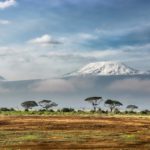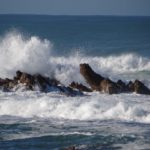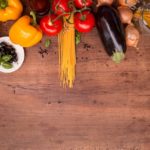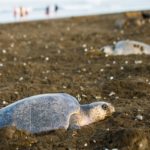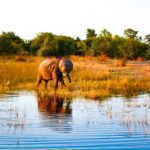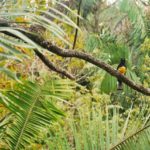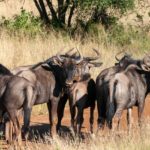A Vegetarian Goes Fishing in South Africa
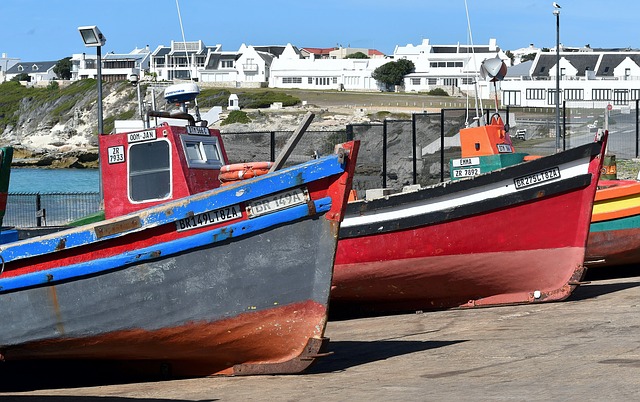
Standing on the small fishing boat, I wedged myself between the cooler of dead fish and the gunwales. I delicately cut a partially-frozen squid in half, the ink squirting all over me and my jacket. I didn’t worry too much as I already had fish and shark blood on it. How did a vegetarian get herself in this predicament, fishing in South Africa? Well, it was all in the name of shark conservation!
Most of my job as a CEO of a travel social enterprise requires sitting behind a computer and making amazing trips happen for other people. I don’t mind! I love that in a year I can help about 200 people go on amazing conservation and animal-welfare trips. In fact, I love providing all these helping hands to centres because I love locally led community conservation programs and because I have visited all these programs first. I know personally what volunteers will be doing and how important those helping hands are.
I go to all the programs before I sent volunteers because I want to know that, as a solo woman traveler, it is safe for me and therefore our volunteers. I also want to make sure the programs are ethical and authentically helping the animals they were designed to. These programs have taken me all around the world, I meet new friends, see animals I didn’t know existed (please Google ‘African spring hare’) and, of course, take part in amazing conservation and animal welfare programs.
In October and November last year I got to visit South Africa to check out a shark conservation program. Two weeks of playing with shark biologists and people who are way smarter than me. I was so excited!
I said sorry every time I cut into a fish, and thank you every time we brought a shark on board. I then apologized to the shark every time I hook the hook out of its mouth.
The program is in Hermanus, in the deeply beautiful Western Cape. Also known as the Whale Coast and Shark Alley, I would be spending two weeks next to the biologically diverse coasts of both the Indian and Atlantic Ocean. All conservation is dependent on not just the biological understanding of the species but also the health of populations and the behavior of individual animals (as well as their families). This means terrestrial animals, while not always easy to monitor and understand, are at an advantage since they can’t escape into the almost infinite abyss that is the ocean.
As an example, the conservation of the wild horses in Mongolia is an amazing adventure, but one that seems relatively easy when you compare the ecosystems and populations. In Mongolia we hike the steppe to find the horses. As there are hardly any trees or other things clogging up your view, finding the horses can be quite easy. But, when looking at populations of sharks, we can’t “just” look on the horizon with our binoculars: we have to snorkel, free dive and fish.
All the fishing I did was, of course, catch and release. This is not perfect, as it still involves a poor shark being dragged up to the boat and having a hook taken from its mouth, but we do de-barb the hook (meaning the hook will slide out of the sharks gill without causing more damage), and only the well-trained get to handle the sharks. Each shark is only on the boat or on the shore for about three minutes. It’s enough time to take the hook out, measure it, tag it, take a fin clip (for DNA tests), and check what sex it is. (Sidebar: Did you know that male sharks have claspers? Please also Google them).
Turns out I quite like fishing in South Africa. Sitting around chatting with people is basically my favorite activity, but then when you catch a shark it’s deeply exciting.
I loved my time on the research boat. We would leave early in the morning (after taking anti-nausea medication, packing a lunch with plenty of ginger cookies and salty crackers to curb seasickness) and go out into the biologically rich waters. On the ride out to pre-determined locations we would see penguins, southern right wales and seals. Sometimes teams see great white sharks! The sharks we fish for vary, from soupfin sharks (about 25kg) and bronze whalers (about 170kg) to puffadder shysharks (about 41cm) and pajama catsharks (about 1m) at their largest.
The two weeks I spent on the project fishing in South Africa we ‘only’ caught smaller catsharks, but I was delighted every single time we caught one because before this, I had never met a shark in real life. I had briefly seen a shark while snorkeling in Oman, but in South Africa I was able to touch them, hold them and even tag them. Thanks science!
Of course to catch them, you have to get your hands dirty and this meant bailing the hook with the most delicious things to a carnivore of the sea: fish. This wasn’t the first time I had the task of preparing meat as a vegetarian. After spending lots of time on animal programs throughout the years, cutting up meat for animals is not my favourite activity but it’s something I know has to get done. At the start of the year I led a group down to a Guatemalan wildlife rehabilitation centre and volunteered to gut fish for the herons, so the other volunteers didn’t have to. When I was in Oman I cut up 20kg of raw chicken for rescue dogs every day. This vegetarian is not happy about it, but she is happy to do it for animals.
I want to know that, as a solo woman traveler, it is safe for me and therefore our volunteers. In fact, I also want to make sure the programs are ethical and authentically helping the animals they were designed to.
Now, while fishing in South Africa, I was cutting up thawed fish and skewering them on a hook to help catch sharks to better understand the populations in the water all around Hermanus. I said sorry every time I cut into a fish, and thank you every time we brought a shark on board. And I then apologized to the shark every time I hook the hook out of its mouth. Most sharks were too little for the hooks and didn’t even get hooked, their small teeth just got caught on the cotton we wrapped the bait in. I still apologized.
In the time I was there we were able to catch and tag about three dozen sharks, which is a lot of data. With the information we collected we know location, bait, time of day, the type of shark, size, sexual maturity and if they are caught again and where. The fin clip that is used for DNA testing tells us even more information. It’s a messy job but I loved every minute of it. It felt so neat to be in the middle of the ocean, helping science in this small way.
Turns out I quite like fishing. Sitting around chatting with people is basically my favorite activity, but then when you catch a shark it’s deeply exciting. It’s also nice knowing these animals are going back to their home with an exciting story to tell their buddies. The cherry on top is knowing that you are helping conserve these animals for future generations.
A Vegetarian Goes Fishing in South Africa.
Hopefully, in time, technology will make conservation easier and less painful for the animals. With less invasive techniques we will be able to understand more about the oceans without having to fish for their residents. The fairly new (in scientific terms) baited remote underwater video (BRUV) technique is where cameras are dropped to the ocean floor and then the footage is interpreted later. Advances like this will help all of us know who lives where in the ocean and how to help them thrive there.
By the way…. does anyone know how to get squid ink out of a rain jacket?

